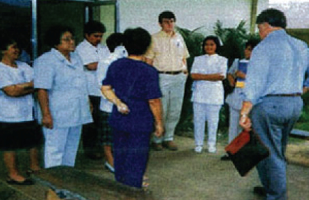
Revitalizing the Health Sector: Quality Service Improvement Program in Nueva Vizcaya
Nueva Vizcaya
2000
When the management of provincial and district hospitals was devolved to the province, the quality of health services deteriorated.
As an initial step, the provincial government expanded the membership of the Provincial Health Board (PHB) from five to 23 to include all health-related organizations in the area. With more than 50% of its members coming from civil society, transparency and accountability were ensured at all levels of decision-making. A Special Personnel Selection and Promotion System was also installed for health workers to participate directly in the hiring of new employees and the promotion of deserving hospital staff. However, complaints on the indifference of the hospital staff continued to pour in.
As a response, QSIP was launched in May 1998 in the provincial and three district hospitals. It started with several focus group discussions to identify the problem and come up with proposed solutions. A performance management system was installed. One of its key features was linking performance evaluation of staff to citizens’ feedback. A Service Excellence Council was created to assist the PHB in monitoring program implementation. A standard customer friendly duty board was imposed for all hospitals in the province. A dress code for healthworkers was adopted to ensure easy identification and ease of movement for faster response time. A Drug Supplementation Program likewise eased the periodic shortage of medicines in hospitals. After two years, a review of patients’ comments changed from complaints to commendations. It exhibited high satisfaction ratings based on survey results. Records from the provincial accounting office showed a 131.5% increase in hospital revenues from 1997 (P 1,103,600) to 1999 (P4,235,200) due to increased patronage for public hospitals where patients were more willing to pay for quality services rendered. There was a marked decrease of people going to the hospital at an advanced stage of illness. They sought treatment and were given attention at an early stage. Other positive effects include the following: Increased awareness on proper customer service management; increased confidence in the internal and external customer surveys; employee empowerment due to establishment of rewards and incentive system; increased linkaging with community-based organizations; improved two-way referral system from primary to tertiary care; and increased networking and coordination among health agencies.
This program is recognized as one of the Ten Outstanding Programs in the 2000 Galing Pook Awards.


